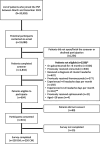Patients' Experiences During the Long Journey Before Initiating Migraine Prevention with a Calcitonin Gene-Related Peptide (CGRP) Monoclonal Antibody (mAb)
- PMID: 39298053
- PMCID: PMC11543966
- DOI: 10.1007/s40122-024-00652-z
Patients' Experiences During the Long Journey Before Initiating Migraine Prevention with a Calcitonin Gene-Related Peptide (CGRP) Monoclonal Antibody (mAb)
Abstract
Introduction: Migraine is under-diagnosed and under-treated. Many people with migraine do not seek medical care, and those who do may initially receive a different diagnosis and/or be dissatisfied with provided care on their journey before treatment with a CGRP-mAb (calcitonin-gene-related-peptide monoclonal antibody).
Methods: This is a cross-sectional, self-reported, online survey of subjects in Lilly's Emgality® Patient Support Program in 2022. Questionnaires collected insights into subjects' prior experiences with migraine and interactions with healthcare professionals before receiving CGRP-mAbs.
Results: Of the 250 participants with episodic and 250 with chronic migraine, 90% were female and white with a mean age of 26.2 years (± 11.9) at diagnosis and 40.6 (± 12.0) years at survey enrollment. Many participants (71%) suspected they had migraine before diagnosis, with 31% reluctant to seek help. Of these, approximately one-third were unaware of treatment, did not think that a physician could do anything more for migraine, would not take them seriously, or were reluctant due to a previous unhelpful experience. Participants mainly received information from friends/family (47%) or the internet (28%). Participants initially sought treatment due to an increase in migraine frequency (77%), attacks interfering with work or school (75%), or increased pain intensity (74%). Subjects saw a mean of 4.1 (± 4.3) healthcare providers before migraine diagnosis, and 20% of participants previously received a different diagnosis. Participants reported migraine causes included stress/anxiety/depression (42%), hormonal changes (30%), nutrition (20%), and weather (16%). Acute treatment of migraine included prescription (82%) and over-the-counter (50%) medications, changes in nutrition (62%), adjusting fluid intake (56%), and relaxation techniques (55%). Preventive medications included anticonvulsants (61%), antidepressants (44%), blood pressure-lowering medications (43%), and botulinum toxin A injections (17%). Most discontinuations were due to lack of efficacy or side effects.
Conclusion: People with migraine describe reluctance in seeking health care, and misunderstandings seem common especially in the beginning of their migraine journey. Graphical abstract available for this article.
Keywords: CGRP monoclonal antibodies; Chronic migraine; Episodic migraine; Galcanezumab.
© 2024. The Author(s).
Conflict of interest statement
Elizabeth Seng: research funding from the National Institutes of Health, Veterans Health Administration, Cystic Fibrosis Foundation, and the American Heart Association, as well as fees for consulting from GlaxoSmithKline, Theranica, and Abbvie. Christian Lampl: consulting fees and honoraria for lectures/ presentations from AbbVie/Allergan, Eli Lilly, Lundbeck, Novartis, Pfizer and Teva. Principal investigator in clinical trials as the for Eli Lilly. Past-president of the European Headache Federation and associate editor for The Journal of Headache and Pain. Lars Viktrup, Margaret Hoyt, Gilwan Kim,, and Dustin Ruff are employees of Eli Lilly and Company and may own Lilly stock. Maurice Vincent was an employee of Eli Lilly and Company when the study was performed and may own Lilly stock. William R. Lenderking, Hayley Karn, Michael H. Ossipov are employees of Evidera.
Figures
References
-
- International Headache Society. IHS Classification ICHD-3: Migraine. 2021. https://ichd-3.org/1-migraine/. Accessed Apr 2022.
-
- Steiner TJ, Stovner LJ, Jensen R, Uluduz D, Katsarava Z, on behalf of Lifting The Burden: the Global Campaign against H. Migraine remains second among the world’s causes of disability, and first among young women: findings from GBD2019. J Headache Pain. 2020;21(1):137. 10.1186/s10194-020-01208-0. - PMC - PubMed
-
- Lipton RB, Munjal S, Alam A, Buse DC, Fanning KM, Reed ML, et al. Migraine in America Symptoms and Treatment (MAST) study: baseline study methods, treatment patterns, and gender differences. Headache. 2018;58(9):1408–26. 10.1111/head.13407. - PubMed
-
- Silberstein SD, Holland S, Freitag F, Dodick DW, Argoff C, Ashman E, et al. Evidence-based guideline update: pharmacologic treatment for episodic migraine prevention in adults: report of the Quality Standards Subcommittee of the American Academy of Neurology and the American Headache Society. Neurology. 2012;78(17):1337–45. 10.1212/WNL.0b013e3182535d20. - PMC - PubMed
LinkOut - more resources
Full Text Sources
Research Materials


